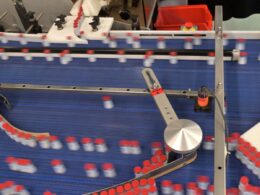This is an excerpt of the report “Supertrends 2022 — Here to stay. From societal trends to investor impact.” , with the title above, focusing on the topic in question.
Credit Suisse
Michael Strobaek; Nannette Hechler-Fayd’herbe, Daniel Rupli
July 2022
Excerpt by
Joaquim Cardoso MSc.
Health Revolution — Institute
Institute for continuous health and digital transformation.
Supertrends — Unit
July 1, 2022
Synthesis of Supertrends:
- 1.Anxious societies — Inclusive Capitalism
- 2.Infrastructure — Closing the gap
- 3.Technology — At the service of humans
- 4.Silver economy — Investing for population aging
- 5.Millennials’ values — Gen Z and Y
- 6.Climate change — Decarbonizing the economy
Synthesis of Technology Trends:
- 1.Digitalization — Meet the Metaverse
- 2.Virtual reality — Living in a virtual world
- 3.Artificial intelligence — Digital age workhorse
- 4.Industry 4.0 — Smarter supply chains
- 5.Healthtech — Now entering the hologram

4.Industry 4.0 — Smarter supply chains
The start of the COVID-19 pandemic in 2020 was followed by significant disruptions to supply chains.
Both developments highlighted the importance and need for greater investment in digitalization.
Building out capabilities for remote working, digital salesrooms or virtual prototyping, as well as increasing the digital expertise of a company are strong trends that have emerged from the COVID era.
Digitalization is also becoming a factor in environmental, social and governance (ESG) criteria, and it is clear that the “smart factory of the future,” including supply chains, should also focus on sustainability.
New technologies including big data analytics, the cloud or the Internet of Things (IoT) are needed to transform a company to a smart (i.e., sustainable) supply chain, as well as provide more exact, predictive information about the behavior of consumers, employees and business partners. According to a McKinsey survey of senior supply chain leaders in 2020, 85% of respondents said they had inefficient digital technologies in the supply chain and 93% said they plan to boost resilience across their supply chain through measures including introducing advanced analytics and adding to their digital supply chain talent 20.
85% of respondents said they had innefficient digital technologies in the supply chain and …
… 93% said they plan to boost resilience across their supply chain through measures including introducing advanced analytics and adding to their digital supply chain talent
Apart from the increased focus on sustainable supply chain investments, the rising usage of 3D digital twins (virtual models designed to accurately reflect a physical object) also remains a strong source of growth for more immersive collaboration, interactive 3D shopping capabilities, simulation & robotics or real-time asset operations.
Relatedly, the “Great Resignation” wave during the pandemic has led to tighter labor markets, but we believe it will be highly positive for automation and robotics industries as employers adopt these technologies to increase productivity and avoid future disruptions.
Robots today man warehouses, deliver food and merchandise, help to perform surgeries and advise financial customers: they are expected to create meaningful competitive advantages for the companies that deploy them.
About the authors
Editor-in-chief
Nannette Hechler-Fayd’herbe
Authors
Daniel Rupli
Reto Hess
Jens Zimmermann
Uwe Neumann
Lorenzo Biasio
Julie Saussier
Pedro Iglesias De La Vega
Samuel Traub
Preface
Michael Strobaek, Global Chief Investment Officer, Credit Suisse
Nannette Hechler-Fayd’herbe, Head of Global Economics & Research, Credit Suisse
Daniel Rupli, Head of Single Security Research, Credit Suisse










